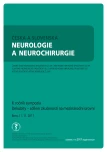Validaton of Nursing Diagnosis of Acute and Chronic Pain According to NANDA International in the Patients with Wound
Authors:
M. Koutná 1; A. Pokorná 2; Lucie Nováková 3; L. Cetlová 4
Authors place of work:
Ambulance hojení ran, Interní oddělení
Strahov, VFN v Praze
1; Katedra ošetřovatelství, LF MU, Brno
2; Vysoká škola zdravotníctva a sociálnej
práce sv. Alžbety v Bratislave
3; Vysoká škola polytechnická Jihlava
4
Published in the journal:
Cesk Slov Neurol N 2017; 80(Supplementum 1): 54-60
Category:
Původní práce
doi:
https://doi.org/10.14735/amcsnn2017S54
Summary
Aim:
The aim of the study was to validate defining characteristics (according to NANDA international) of the nursing diagnoses “acute pain” (00123) and “chronic pain” (00133) and their meaning as well as the mostly subjective feelings for the patients with different wound and pain.
Material and methods:
The data were acquired from outpatient clinics for wound healing and from inpatient wards from various localities of the Czech Republic (n = 180 patients). The study followed „Patient focus CDV model“.
Results:
The most frequent defining characteristics of “acute pain diagnose” was „looking for pain relieving position” (weighted score 0.93), and of “chronic pain diagnose” „fear of appearance of another wound” (weighted score 0.74). We have verified correlation between the age of the respondents and intensity of pain and the numeric value of the average defining characteristic score (p ≥ 0.05).
Conclusion:
Weighted score values above 0.8 were found in patients with a pain intensity ranging from 7– 10 points – severe pain (10-degree scale). Under these conditions, patients selected as the most important defining characteristics: „looking for pain relief position, protective behaviour, observed signs of pain and frequent pain“. Defining characteristics of the nursing diagnosis „chronic pain“ were lower in the weighted score but highlighting features typical of long-term issues such as non-healing wounds: „fear of another wound formation, limited mobility at the site of pain, observed protective behaviour and persistent pain”.
Key words:
NANDA International – nursing diagnoses – validation – defining characteristic – pain – patient
The authors declare they have no potential conflicts of interest concerning drugs, products, or services used in the study.
The Editorial Board declares that the manuscript met the ICMJE “uniform requirements” for biomedical papers.
Zdroje
1. Stryja J. The importance and limits of the pressure ulcer surgical debridement. Cesk Slov Neurol N 2016;78/ 111(Suppl 1):S25– 7. doi: 10.14735/ amcsnn2016S25.
2. Solowiej K. Take is easy: how the cycle of stress and pain associated with wound care affects recovery. Nursing & Residental Care 2010;12(9):443– 6.
3. NANDA INTERNATIONAL. Ošetřovatelské diagnózy. Definice a klasifikace. Praha: Grada 2012– 2014.
4. NANDA INTERNATIONAL. Ošetřovatelské diagnózy. Definice a klasifikace. 10. vyd. Praha: Grada Publishing 2015– 2017.
5. Koutná M, Pokorná A. Znalosti a zkušenosti sester konzultantek pro hojení ran v managementu bolesti u nemocného s ránou. Bolest 2017;17(1):32– 41.
6. Fehring RJ. Methods to validate nursing diagnosis. J Critical Care 1987;16(6):625– 9.
7. Zeleníková R, Žiaková K, Čáp J, et al. Návrh kritérií výberu expertov pre validizáciu ošetrovateľských diagnóz v ČR a SR. Kontakt 2010;12(4):407– 13. doi: 10.5507/ pol.2012.008.
8. Neil MJE, Bannister J. When acute pain becomes chronic. Anaesthesia 2015;70(7):779– 83. doi: 10.1111/ anae.13145.
9. Tommey M. Gender Differences in Pain: Does X = Y? AANA J 2008;76(5):355– 9.
10. Matsuzaki K, Upton D. Wound treatment and pain management: a stressful time. Int Wound J 2013;10(6):638– 44. doi: 10.1111/ j.1742-481X.2012.01038.x.
11. Sueki DG, Dunleavy K, Puetedura EJ, et al. The role of associative learning and fear in the development of chronic pain – a comparison of chronic pain and post-traumatic stress disorder. Physical Therapy Review 2014;19(5):352– 66. doi: 10.1179/ 1743288X14Y.0000000154.
12. Woo KY. Untravelling nocebo effect: the mediating effect of anxiety between anticipation and pain at wound dressing change. J Clin Nurs 2015;24(13– 14): 1975– 84. doi: 10.1111/ jocn.12858.
13. Upton D, Solowiej K, Hender C, et al. Stress and pain associated with dressing change in patients with chronic wound. J Wound Care 2012;21(2):53– 4. doi: 10.12968/ jowc.2012.21.2.53.
14. Bueno M, Yamada J, Harrison D, et al. A systematic review and meta-analysis of nonsucrose sweet solutions for pain relief in neonates. Pain Research 2013;18(3):153– 61.
15. Jones J, Barr W, Robinson J, et al. Depression in patients with chronic venous ulceration. Br J Nurs 2006;15(11):17– 23.
16. EWMA Position document – pain at wound dressing changes 2002. [online]. Available from URL: http:/ / www.woundsinternational.com/ pdf/ content_11.pdf.
Štítky
Detská neurológia Neurochirurgia NeurológiaČlánok vyšiel v časopise
Česká a slovenská neurologie a neurochirurgie

2017 Číslo Supplementum 1
- Metamizol jako analgetikum první volby: kdy, pro koho, jak a proč?
- Fixní kombinace paracetamol/kodein nabízí synergické analgetické účinky
- Tramadol a paracetamol v tlumení poextrakční bolesti
- Realita liečby bolesti v paliatívnej starostlivosti v Nemecku
Najčítanejšie v tomto čísle
- Validizace ošetřovatelské diagnózy akutní a chronická bolest dle NANDA International u pacientů s ránou
- Využití lalokových plastik v operační léčbě dekubitů
- Diferenciální diagnostika dekubitů a dekubity vznikající v souvislosti s přístrojovou technikou
- Dekubity jsou pro mne stále noční můrou
